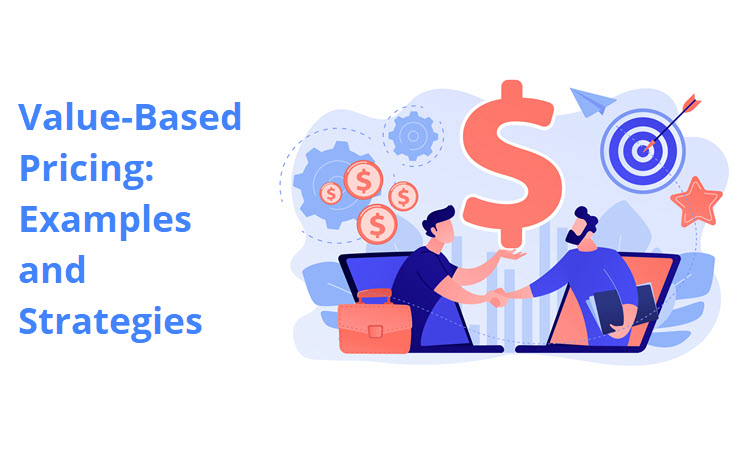Pricing isn’t done arbitrarily. It takes research and calculations to come up with the right price for every product.
If the price is too low, the business won’t make enough money to survive. On the other hand, overpriced products won’t attract enough customers to ensure proper revenue.
Value-based pricing is a strategy revolving around shoppers’ readiness to pay a certain price for a product.
In this article, we’ll discuss how the value-based pricing strategy works and when this model is commonly used.
What Is Value-Based Pricing?

Value-based pricing is based on the product’s perceived value and the customer’s willingness to pay a specific price for a product.
In this model, prices are not based on production costs or competitors’ prices.
It’s the value before the price that counts in the value-based pricing strategy. When a customer is satisfied with the value they get, they’re more likely to pay a higher price.
Ecommerce businesses use market research to determine the value their products bring to target customers. They use the collected data to set the highest price that target customers are ready to pay for the products.
What Are the Two Types of Value-Based Pricing?
The two main types of value-based pricing are:
- Value-added pricing. Value-added pricing refers to adding all features and elements that differentiate your product and justify higher prices. It highlights how a product is different and why it adds extra value for buyers.
- Good-value pricing. Good-value pricing convinces buyers that the product features and quality are worth its price because they solve their practical problems.
Who Is Value-Based Pricing for?

A value-based pricing strategy is most suitable for SaaS businesses and high-end brands.
Bear in mind that value-based pricing is suitable for products that have similar counterparts on the market. It’s not a practical pricing strategy for products, devices, or services that are new to the market.
Value-Based Pricing for SaaS
SaaS companies often use value-based pricing because it’s a dynamic and responsive pricing model.
When a merchant sets prices for tiers of services, they need to know how many buyers would opt for each of the tiers. After surveying the target market, it is divided it into segments and tiers are packed with elements accordingly.
Note: Learn more about the tiered pricing model to combine these two pricing strategies for a SaaS business.
Renowned Brands and Value-Based Pricing Strategy
Renowned brands selling more expensive products can count on a larger market segment responding to value-based pricing. For instance, when such companies add new features to some of their existing products, they generate new value to customers. This additional value justifies a price increase.
The same principle applies when these companies launch new products.
Examples of Value-Based Pricing
Apart from SaaS companies, businesses in different industries opt for value-based pricing to boost revenue and establish deeper connections with their customers.
These are the most common niches in which this pricing model is used:
- Fashion. Premium brands rely on the value-based pricing strategy to target top-paying clients and boost their revenue.
- Medical services. People often don’t ask for the price when their health is in danger. So, private providers of medical services often set prices that are much higher than costs.
- Cosmetic products. Shoppers tend to spend more on beauty products. Merchants in this niche are aware of this, so they use value-based pricing.
- Technology. Retail and ecommerce stores use value-based pricing to sell TVs, computers, cellphones, and other devices at higher prices than their competitors.
Note: Value-based pricing is a great pricing model whenever products are scarce or customers have an intense emotional investment in the shopping process.
How Does Value-Based Pricing Compare to Cost-Based Pricing?
There’s one significant difference between value-based pricing and cost-based pricing. Value-based pricing requires market research before determining the price.
In the cost-based pricing strategy, there’s no market analysis. Merchants calculate the production costs per product and add the desired profit margin. Buyers’ expectations from the product aren’t taken into account in this pricing strategy.
Value-based pricing focuses on external elements – market segments, their expectations, and their willingness to pay.
Contrary to that, cost-based pricing has an internal focus – only costs and expected earnings.
What Are the Pros and Cons of Value-Based Pricing?

Using value-based pricing brings certain pros and cons, as explained below.
Pros
Higher Earnings
When merchants use the value-based strategy from the beginning, they’re able to charge the maximum price for their services from day one.
Those higher earnings are beneficial in the long run, since they ensure faster business development and more investments. As merchants add more features to their products and services, they add more value for their subscribers. Consequently, they charge more for their products.
By doing this, they avoid underpricing or overpricing their products, but get as close to perfect pricing as possible.
Note: When using value-based pricing, revise the pricing structure every six months to reflect product improvements and added value.
Deeper Insights
When merchants collect data for the value-based pricing strategy, they gather additional details about their customers.
In addition to price preferences, they find out what different segments of potential customers expect from the products and services in question. They might find out more about different social backgrounds of different segments, as well. Merchants that include those findings in their offers are more likely to offer the right products to the right customers at the right prices.
During this process, they also learn more about the market itself and the competition.
Improved Product Quality
When using value-based pricing, merchants need to keep delivering high-quality products that bring value.
Understanding how customers perceive their products gives merchants a different point of view. They learn what features they must improve to reach the desired value of products and services.
Continuously improving quality also increases the repeat purchase rate and ensures a higher customer retention rate. Repeat customers that trust a brand boost the overall price of a product.
Enhanced Customer Service

Since value-based pricing is a customer-centered strategy, merchants can use it to enhance customer service. Customers share their opinions and expectations with merchants during surveys and interviews. Merchants use that information to set prices that reflect their business goals and customers’ expectations.
Apart from prices, merchants can use the customer data to anticipate and mitigate potential issues.
These processes deepen the relationship between merchants and customers, strengthen customer loyalty, and reduce the churn rate.
Cons
More Expensive to Implement
Compared to other pricing structures, value-based pricing is more expensive to implement.
Merchants must conduct market research, process the collected data, and segment the target market. Based on the data collected, merchants create buyer personas for every segment.
Although value-based pricing isn’t based on competitors’ prices, merchants still need to analyze what value their rivals bring to buyers. This comparative analysis incurs some costs, as well.
Once a merchant determines prices via value-based pricing, they need to monitor customers’ reactions and change prices when necessary. All these operations increase overall business costs.
Lengthy, Semi-Reliable Process
The value-based pricing strategy demands patience and time from merchants. The entire data-collection process may last from several days to several months.
What’s more, the information gathered isn’t completely reliable and accurate. It’s an approximation that can help merchants set their prices, but those prices don’t always turn out to be the right ones.
Businesses that want to start selling items immediately don’t have time for those preliminary activities. They usually opt for other pricing strategies to speed things up and start making money.
How to Calculate and Implement Value-Based Pricing

Let’s go through a value-based pricing example to see how it works in practice.
Let’s say Company X wants to sell a new cellphone. They can take the following steps to calculate and implement value-based pricing:
- Research competitors. Value-based pricing requires comparison with peer products. Company X would research the prices and features of other cellphones and identify which products are their direct competitors. Company X’s direct competitor, Company Y, is already selling a cellphone with similar features at $699.
- Set the differentiation terms. Determine the vital features that distinguish your product from competitors’ and calculate how much each of them is worth. For Company X, this calculation wouldn’t include all the features that both Company X and Y’s cellphones have, but only the ones that are unique to Company X’s cellphone.
- Conduct target market research. Use questionnaires, interviews, and polls to figure out who your potential customers are and how much they would be willing to pay for your product. The target market for Company X’s product is people willing to pay $699 or more for a cellphone. They might see Company X’s cellphone as a problem solver (e.g., they need it for work) or as a status symbol.
- Set a price. Using the data collected, set a price that reflects the highest amount your customers are willing to pay for the unique value you offer over your competitors. Based on market research and comparison to competitors’ products, Company X sets their cellphone’s price at $799.
- Launch marketing campaigns. The value-added and good-value models described above can help you use value-based pricing to sell your product. Company X’s marketing team can promote the cellphone by highlighting the features that outperform the competitor’s device.
In some cases, the merchant doesn’t get the full price they set via the value-based pricing strategy. For instance, in some fields (e.g., the automotive industry or real estate), sellers sometimes reduce the set price via negotiations by giving discounts for cash payments or other deals.
Note: Learn everything you need to know about SaaS Billing.
Conclusion
A good pricing strategy is key to effective financial management. If you set the right price, you’ll save a lot of time and start making money quickly.
Follow the information in this guide to determine whether value-based pricing is the right option for your venture and how to implement it for faster business growth.
